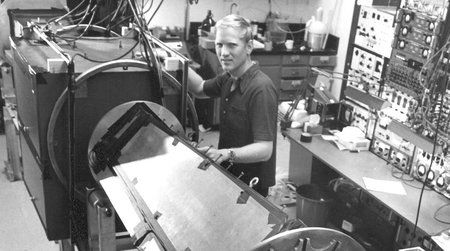Are particles really connected across space? - Quantum Entanglement

The characteristic of quantum entanglement lies at the heart of quantum physics and can lead to major breakthroughs in all kinds of technology, especially quantum computing. Just like most other aspects of quantum physics, the phenomenon of entanglement reveals itself at the scale of subatomic particles. When this phenomenon arises and two particles like photons or electrons become entangled, they remain at this stage even when separated by vast distances. In the same way that a tango emerges from two individual dancers, quantum entanglement arises from the connection between particles, which is called an emergent property.
If we happen to generate a pair of entangled particles we most likely send them to different locations to test the property of their correlation. Let's say we want to measure the spin of the entangled particles, which can be either up or down along a given axis. Before any measurement is taken the particles will be in a state known as superposition. From this follows that both particles spin up and spin down at the same time.
When we now measure the spin of one of the entangled particles we break the superposition and the particle can only be in one state. Furthermore, if we now measure the other particle, we will always find some sort of correlation. If one particle's spin is up, the other's will be down (the spins may instead both be up or both be down, depending on how the experiment is designed, but there will always be a correlation). This shows the beauty of entanglement, because if we know the state of one of the particles we can already define the state of its companion, even when vast distances separate them.
We can still ask ourselves if the observed particles are really connected. Several scientists, including Albert Einstein, pointed out that the entangled particles might always spin up or down, but that the information was hidden from us until the measurements were made. Such “local hidden variable theories” argued against the aspect of entanglement, and instead proposed a yet unseen property.
Thanks to theoretical work by John Stewart Bell and experimental work done by John Clauser in the 1960s up until the 1970s, scientists have ruled out these local hidden variables theories. A key to the success was observing entangled particles from different angles. In the experiment explained above this would mean that we first measure the spin of one particle but then use a different viewing angle to measure the other particle. Now the two particles don't match up as before but the second particle goes back into a state of superposition and after observing it would either spin up or down. The choice of the viewing angle changed the outcome of the experiment, which means that there cannot be any confidential information buried inside a particle that determines its spin before it is observed. This gives us evidence that entanglement arises not from one particle but from the connection between them.
If you have enjoyed this episode of THE SUNDAY NIGHT SKY and you don't want to miss out on any future episodes consider subscribing for FREE.
Thanks again and I'll see you soon.
xoxo
Victor 👋 :) (@observethecosmos)
✍️ Quote of the week
“Spooky action at a distance.”
Albert Einstein
🎟 Want to advertise on The Sunday Night Sky? → Send an E-Mail
Check out some of my social media pages to learn more about math, science and astronomy:
🎬:Youtube